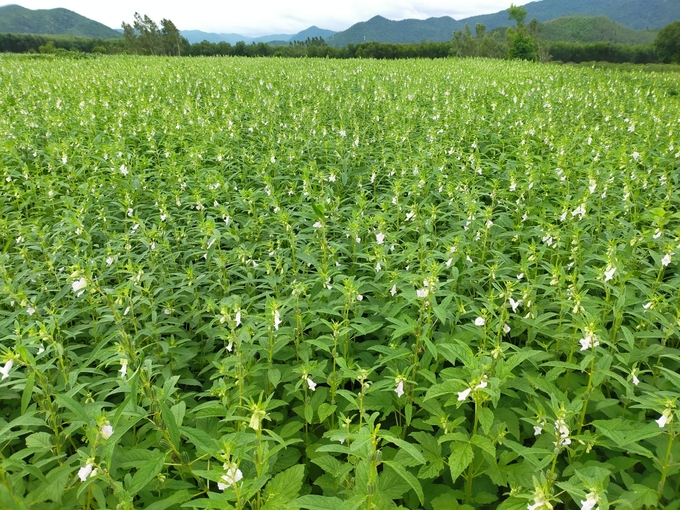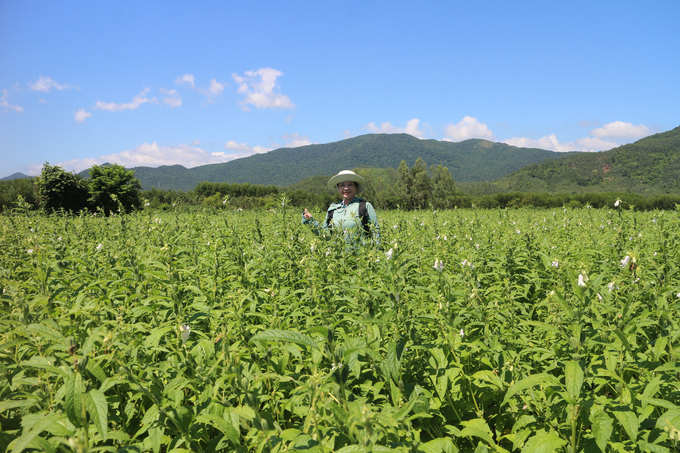Tay Son is a midland district of Binh Dinh province with very harsh weather and climate especially in hot season. In recent years, agricultural production in Tay Son District has become increasingly unfavorable due to the influence of climate change due to drought.
In response to climate change, Tay Son has increased the sesame acreage in the region in recent years, since sesame is a highly drought-resistant crop that hardly needs irrigation water, thus contributing to the conversion of sesame seeds. The restructuring of crops on paddy fields without irrigation water and on fields where sugar cane and cassava (cassava) are grown is inefficient.

Model of intensive sesame cultivation on converted land in Thuong Giang Village 1, Tay Giang Township (Tay Son District, Binh Dinh). Picture: VDT
At present, there are 500 ha of sesame in Tay Son district, the average yield is 9 quintals/ha. This yield has increased compared to previous years, but is still low because local farmers use old sesame seeds that have spoiled and therefore have low resistance to pests and diseases.
Due to the above fact, in 2023, Binh Dinh Ministry of Agriculture and Rural Development instructs provincial agricultural extension center to coordinate with Tay Son district agricultural service center to implement a model of intensive sesame cultivation on converted land to techniques transferred to. art for farmers. Simultaneously evaluate the productivity and economics of converting cassava, sugar cane and beans to other local upland crops. The model was built in the summer-autumn harvest of 2023 in Thuong Giang 1 Village, Tay Giang Township (Tay Son District) covering an area of 2 hectares where inefficient rice cultivation used to be practiced, with 6 participating farmer households.
According to Ms. Vo Nguyen Bich Thuy, Technical Director of Binh Dinh Agricultural Extension Center, thunderstorms occurred in the beginning and middle of the 2023 summer-autumn harvest in Tay Giang Township, affecting the growth and development of sesame . However, thanks to the farmers participating in the model, they consciously learn new knowledge and techniques and apply them in practice, so the cycads in the model give positive results.

The intensive cultivation of the sesame variety V36 resulted in the highest yield of all time with 65 kg/Sao. Picture: VDT
“Currently, farmers in the Thuong Giang Agricultural Cooperative area have planted 15 hectares of sesame. In the past, people bought floating seeds, so the yields of sesame plants were low. To implement the model of intensive sesame cultivation on converted land of Binh Dinh Agricultural Extension Center, we use the V36 sesame variety selected by the Institute of Agricultural Science and Technology on the South Central Coast for the highest yield yet 65 kg/sao (500 m2 ),” said Mr. Tran Dinh Tho, director of Thuong Giang 1 Agricultural Cooperative.
Mr. Tran Dinh Tho remarked that due to actual production, sesame variety V36 has a short growing time of only 75 days. This variety of sesame grows and develops stably in dry conditions, the average tree height is 1.45 m, the leaves are large and green; long fruit, with 4 compartments (4 segments), 8 rows of seeds; Each leaf eye has 2-4 fruits.
“The factors for the production of the Sesame V36 variety are due to the fact that the average number of firm fruits reaches 18 fruits/tree, the number of firm seeds reaches 14 seeds/row; The weight of 1,000 seeds reached 2.8 grams; Actual yield is estimated at 13 quintals/ha,” said Mr. Tho.
According to Mr. Tho, the monitoring of the pest situation in V36 sesame in the model in the 2023 summer-autumn harvest shows that the pests and diseases are not significant in the V36 variety; Leaf rollers, borers, aphids, aphids only cause isolated damage. As for the diseases, only root rot and leaf spot disease appeared, but thanks to timely care and prevention by farmers, it had little impact on yield.

Ms. Vo Nguyen Bich Thuy, technical manager of Binh Dinh Agricultural Extension Center, visited the model of intensive sesame cultivation on converted land in Thuong Giang Village 1, Tay Giang Township (Tay Son District, Binh Dinh). Picture: VDT
“The investment cost of growing V36 sesame is more than VND 2.1 million/Sao, while the investment of wheat field is more than VND 1.7 million/Sao. The sesame yield is 65kg/Sao, the current selling price in the field is between 45,000-48,000 VND/kg. Meanwhile, the cassava plant cultivated on the same foot of the earth has a yield of 1,200 kg/Sao, the selling price is only 2,100 VND/kg, so the profit of the field in the sesame cultivation model is higher than that of the cassava plant by 768,000 VND/pole. The income of the sesame cultivation model is more than VND 2.3 million/Sao, which is higher than that of the non-wheat model field, which is more than VND 1.5 million/Sao,” said Mr. Tran Dinh Tho, director of Thuong Giang Agricultural Cooperative 1st frugal calculations.
“V36 is a short-term variety with a growing period of about 75 days in the summer-autumn harvest of 2023 on Tay Giang land, suitable for designing a crop rotation of 3 crops/year. The variety has good heat tolerance, good pest resistance and good fall resistance.
If a short-term crop rotation according to the formula peanut – sesame – corn (maize) per year is carried out on the same bare foot, the profitability is very high. On the other hand, if you only grow noodles, you can only grow one kind of crop per year, so the production efficiency is low, the soil degrades quickly, and the pest pressure is high,” said Mr. Tran Dinh Tho, director of Thuong Giang Agricultural Cooperative.

